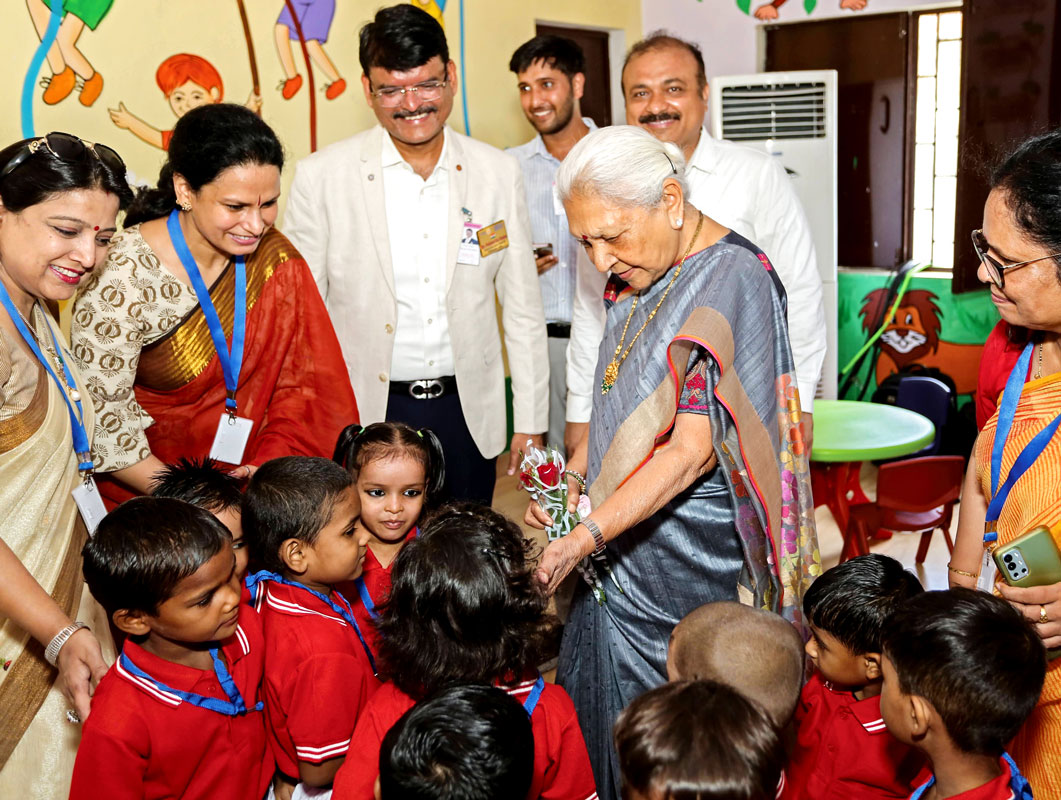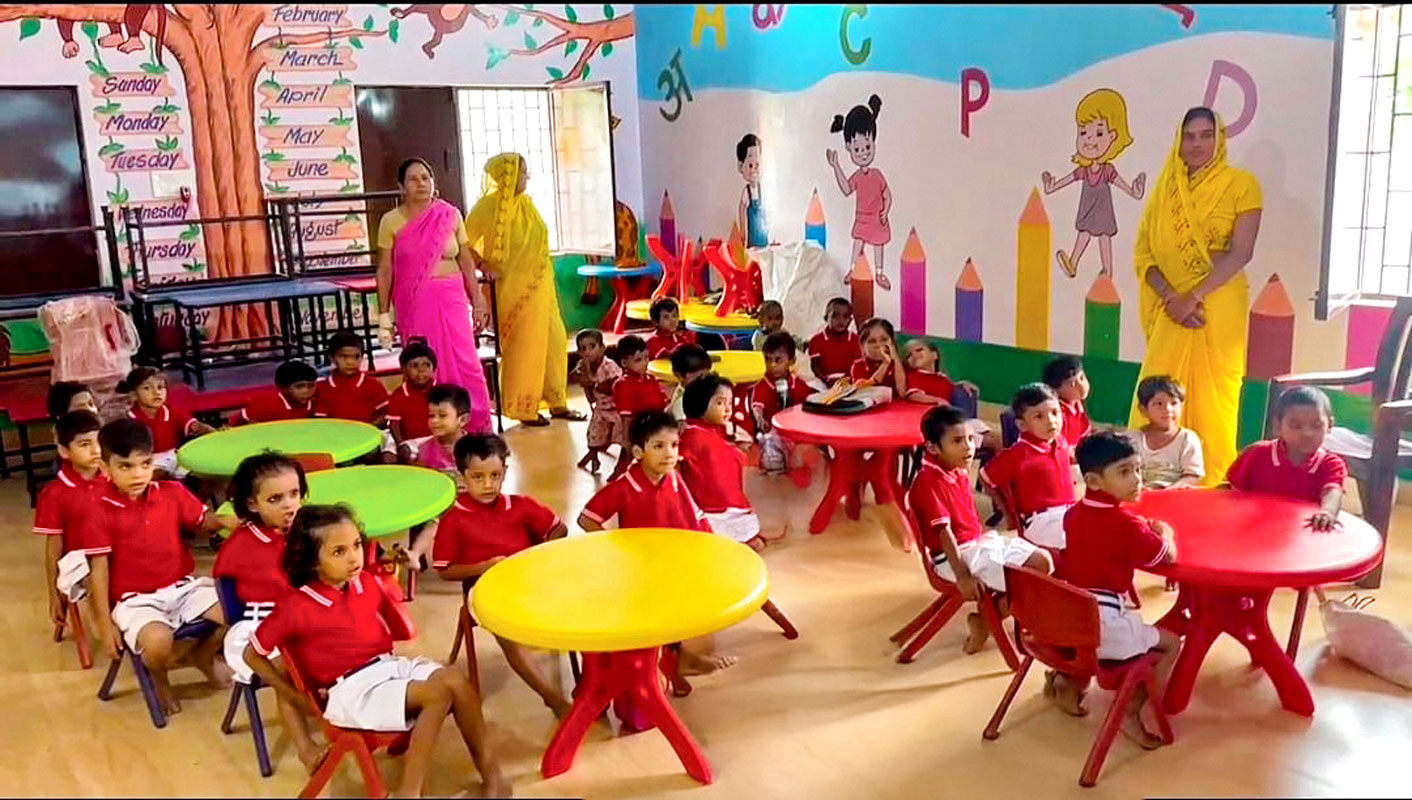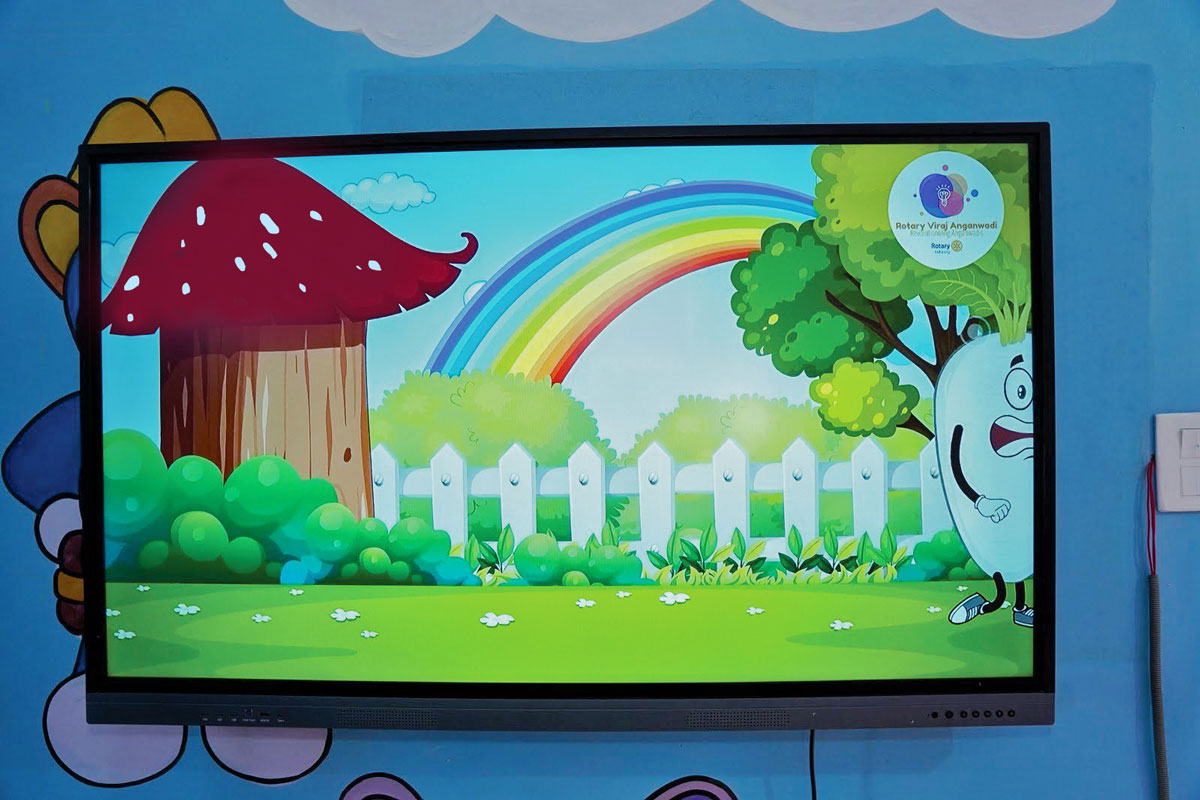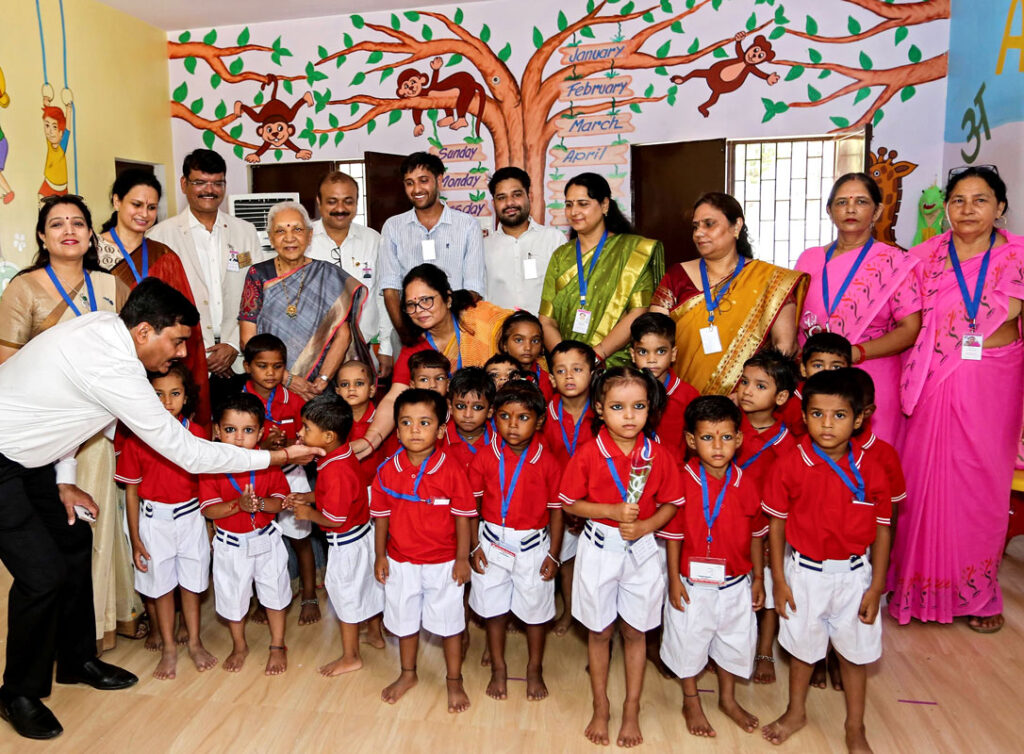In an ambitious project to apply one of the latest technological tools — Artificial Intelligence (AI) — to revolutionise the learning methods of Indian children from underprivileged backgrounds who attend anganwadis, which are poor children’s equivalent to the plush and fun-filled playschools frequented by the rich and upper class urban Indian children, RI District 3012 has launched an interesting and futuristic project in Uttar Pradesh.

Titled the Rotary Viraj Anganwadi Project – Nanhe kadmo ki udaan — this project hopes to dramatically change the basic functions of an anganwadi, which is to provide basic learning to children and address the healthcare and nutritional needs of both children and pregnant women. RID 3012 DG Prashant Raj Sharma, who is passionate and fully invested in this project, says it is common knowledge that the average anganwadi in India is lacking in so many ways — indifferent infrastructure, untrained and unenthusiastic teachers and absence of an interesting, interactive environment, resulting in failure to retain students beyond a certain stage.
“The teachers lack the skills required to facilitate engaging and effective learning experiences for students, particularly in grasping fundamentals. Furthermore, anganwadi schools lack a monitoring system which can tell us about the students’ or expectant mothers’ progress. In fact, there is little or no information on even the opening and closing hours of these anganwadis,” he says.
To dramatically transform this dismal scenario, this project, launched in partnership with the CSR partner AMU Lines which has donated $55,000 of the total project cost of $225,000, aims to bring a transformational change to 100 anganwadis in Uttar Pradesh. In alignment with two of Rotary’s focus areas of maternal and child health, and literacy and basic education, the first colourfully painted and embellished anganwadi, complete with spanking new furniture and an interactive smartboard, at Morti village, about 3km from Ghaziabad city centre, was inaugurated by UP Governor Anandiben Patel.

In an interview to Rotary News, DG Sharma explained his vision to use various facets of technology, including AI, to ensure that the underprivileged children attending anganwadi schools get a meaningful learning experience, and the expectant mothers get what they are promised, comprehensive healthcare and nutrition. “Right now, most of the children are sent to the anganwadis by their parents mainly because they get a meal there. What they are taught there hardly matters to them. But all this will change, and is already changing as we have seen after the first Viraj Anganwadi was inaugurated this August in Morti,” says the DG.
Medical research has shown, he says, that the optimum development of the brain takes place in a child in between 3 and 6 years, and this is the age group that attends anganwadi classes. To engage the attention of these young children, in this project a smartboard has been specially designed and developed in which interactive learning material is loaded.
“We have developed a dashboard in which all study material, including quiz, stories, play material, poems and jingles, which can hold a child’s interest, and is interactive in nature, is loaded. It is designed in such a way that individual children’s activities can be monitored; supposing there are 50 children in the school, their individual activities… what they enjoy the most, the way in which they learn and so on, is monitored.”

The digital screen is much more than a smart learning device; it allows the government to monitor learning outcomes, standardise lessons and try to keep up with private playschools to which only the privileged children have access. The dashboard is connected to a state government facility, where the education officers have access to all the data mined and analysed with the help of AI.
The attempt is to replicate learning that is interesting and fun and is on offer in the best of urban playschools. With the help of the AI tool, the child’s overall development — what she has learnt, absorbed, imbibed, finds interesting, the questions asked, and the time spent on each activity, will all be analysed, and a module developed, which can then be applied to anganwadis across the state, or even the country.
“Our primary goal is to provide quality education to young students at an early age, and adopt a holistic approach to education, ensuring that every aspect of a child’s development is nurtured during these formative years between 3 and 6, using technology for quality education. It is crucial to provide high-quality education during this period to strengthen cognitive abilities, enabling children to effectively read, understand, grasp, and retain what is taught to them,” says Sharma.

In the belief that this initiative represents “a significant leap forward in community service,” he and his team have a mega plan to transform 100 anganwadis by making them tech-savvy in the first phase expected to be completed within this Rotary year. Towards this goal 70 clubs from the district have been identified to take charge, equip the anganwadis with the required smart learning and healthcare tools, and take responsibility for maintaining them in working state for at least three years. The agreement with the vendor ensures an AMC for three years, so that the experience is not a mere flash in the pan. The clubs have also been asked to give the children uniforms, so that they feel they are attending a regular school and would take their lessons more seriously.
While the CSR partner is contributing almost a fourth of the funding required, the clubs will be raising the remaining money, and “whatever they raise will go towards their contribution to The Rotary Foundation,” says Sharma. Apart from sprucing up the infrastructure, and providing comfortable tables and chairs for the children, the Rotarians are also taking care of ensuring uninterrupted power supply, by providing an inverter, as in rural areas the supply tends to be erratic. He makes it clear that the Rotarians will not be spending money to build or improve the physical structure of the anganwadis, and will choose centres with decent buildings that can be converted into modern learning centres.
Sharma explains that this project is more than “bringing cutting-edge technology to the forefront of community service and setting a new standard for anganwadi centres across the country.” The application of AI to monitor the data, and tweak it to suit different regions and community groups, will have a far-reaching impact on the way we can reach meaningful learning to less privileged children, and equip them to perform/compete better, when they go to primary schools and continue their education. Data will be collected and analysed not only on learning outcomes but also the health and nutritional status of the children and expectant mothers visiting the anganwadis.
The AI linkage
Once the data is analysed with the help of the AI component, the state’s nodal education officers can monitor the progress of children, and decide what really interests them by studying how much time the children spend on each activity.
Explaining the linkage with AI and the justification for calling these ‘AI-anganwadis’, Manu Seth, Social Media chair of RID 3012, and a pioneer in introducing new ICT technologies in India, says the integration of the latest technological developments such as AI will help make the learning system in these anganwadis “more robust and up to date with modern education modules across centres through updated dashboards, which in turn will help the education officers in the district or state to take quick, responsive and corrective measures. AI can assess the progress of the children and suggest modifications in the system or curriculum to improve the learning process. The key objective is to quickly bring the benefits of the latest education interactive techniques to the little ones at these anganwadis. Aso, it helps government bodies to keep live track on what is happening at the anganwadis on an as-and-where basis.”
DG Sharma says the results of the interactive smart boards where the ‘A for apple’, other alphabets demonstrated with objects and numbers, come to life in vibrant colours on the smart board, which the children can touch, making learning a fun activity, are already evident.
“The children are excited and the strength of the anganwadi has gone up from 30 to 45 in a short while. In the last one week, not a single student has come late to the centre,” says Sharda, a child development officer in Ghaziabad. Adds the DG, “Earlier the parents used to send the children to school only for the noon meal, and that too after the helpers would knock on their doors to persuade them to send their kids to the centre, but now the parents are bringing them ahead of time. Rotary has kindled a hope in their hearts that their children will henceforth get a quality learning experience.”
In a significant signal that the UP government is keenly interested and invested in this project, Governor Anandiben, who inaugurated the first technology-integrated anganwadi at Morti, “spent a lot of time asking us detailed questions and interacting with the students and the teachers. She wanted to know how the state government could expand its reach,” says Sharma. The inaugural event was attended by senior state leaders such as UP minister Sunil Sharma, MLAs Ajitpal Tyagi and Manju Shivach, Ghaziabad mayor Sunita Dayal, district magistrate Indra Vikram Singh and chief development officer Abhinav Gopal.
More important, Sharma is excited that the Governor has expressed interest in replicating this project in a few anganwadis in Prime Minister Modi’s constituency in Varanasi, which is in UP. “If and when this happens, she has promised us that she will try and get the PM to inaugurate such an anganwadi in Varanasi,” he says, hoping that this model will inspire other Rotary districts to explore similar innovations in community service that promise to revolutionise early childhood education and maternal care.
The objectives are lofty enough; as DG Sharma says, “The Viraj Anganwadi is an innovative AI-driven solution dedicated to delivering quality and fun-filled educational content using technology, which enables interactive lessons, multimedia presentations, and gamified educational experiences, enhancing student engagement and comprehension.” The software is designed to facilitate progress monitoring, providing real-time updates on students’ learning journeys and generating comprehensive reports on the current status of the anganwadis selected for this project. He adds that through a year-long planned system, these digital boards can facilitate comprehensive lesson plans, interactive activities, and multimedia content tailored to the curriculum, ensuring a systematic approach to learning throughout the year. An impact assessment will be made early next year once all the 100 anganwadis are completed. “I would say such an AI-based anganwadi is more than just a facility; it’s hope for childhood care and development.”
Key features of AI-powered anganwadi

The special attributes of the modern anganwadi as explained by RID 3012 DG Prashant Kumar Sharma include:
- Enhanced learning experience: It will provide students with interactive and multimedia-rich educational content, making learning more engaging and effective.
- Teacher support: The AI solution will serve as a valuable aid for teachers, enabling them to explain concepts to students more easily and effectively.
- Monitoring of centres: The integration of smart digital boards will enable real-time monitoring of the anganwadi centres and allow supervisors and administrators to track attendance, assess teaching effectiveness, and identify areas for improvement.
- An intro to digital education: By incorporating smart digital boards, such an anganwadi will introduce the young child to digital learning tools and technologies, preparing and equipping her for the digital age by providing essential skills for the future.






